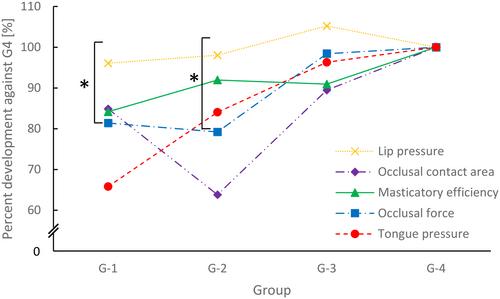This cross-sectional study aimed to investigate the age-related development of five major oral functions—tongue pressure, lip pressure, masticatory efficiency, bite force, and occlusal contact area—in subjects aged 5–20 years.
Ninety-two subjects were divided into four age groups: 5–8, 9–12, 13–16, and 17–20 years. Oral functions were evaluated using standardized methods, including Chew Check Gum for assessing masticatory efficiency, Dental Prescale II for measuring occlusal force and contact area, JMS tongue pressure measuring device for evaluating tongue pressure, and Ripple-Kun for measuring lip pressure.
Occlusal contact area, maximum bite force, tongue pressure, and masticatory efficiency gradually increased with age, whereas lip pressure remained stable. The occlusal contact area temporarily decreased between 5 and 12 years of age, likely due to the replacement of erupting lateral teeth. Some differences were observed between males and females; however, overall trends in oral function parameters were similar. Spearman's rank correlation analyses revealed significant positive correlations between age and occlusal contact area, bite force, tongue pressure, and masticatory efficiency.
Oral function parameters exhibited different age-related development patterns. Occlusal contact area, maximum bite force, tongue pressure, and masticatory efficiency gradually increased with age. Interestingly, the occlusal contact area tended to reduce temporarily between 5 and 12 years of age due to the replacement of erupting lateral teeth. Conversely, lip pressure was almost stable during this period. Our findings provide valuable insights into the developmental patterns of oral functions during the growing years.



